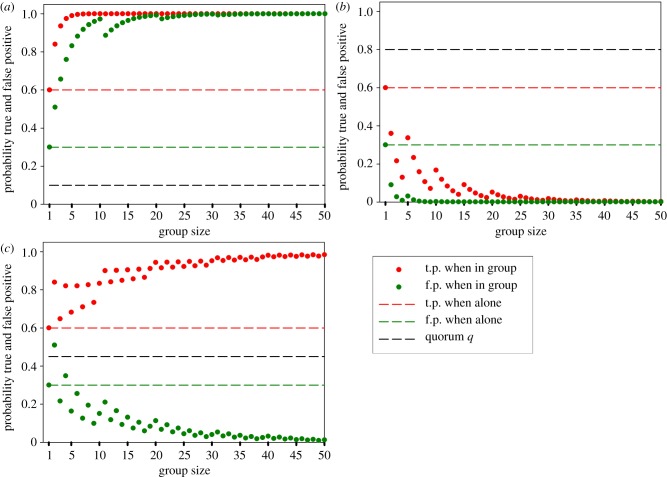Figure 2.
Intermediate quorum thresholds allow decision-makers in groups to overcome the trade-off between true and false positives that solitary decision-makers face. We consider a group of N decision-makers that is confronted with a scenario as depicted in figure 1, each decision-maker uses a decision threshold t that gives rise to true positives ptrue+ and false positives pfalse+. We assume that decision-makers use the following 2-step quorum decision rule: ‘indicate to take action A whenever your personal information indicates that you should take action A (i.e. whenever the perceived cue intensity x exceeds the decision threshold t, figure 1), take action A when at least a fraction q of the other group members indicate to take action A’. The consequences of this rule are illustrated for (a) a low, (b) a high and (c) an intermediate quorum threshold q (hatched black line). (a) For low thresholds (q = 0.1), increasing group size gives rise to increased true positives (red dots), but these increases are associated with increased false positives (green dots). (b) For a high thresholds (q = 0.8), increasing group size gives rise to decreased false positives, but these decreases are associated with decreased true positives. (c) A very different scenario occurs for intermediate thresholds (q = 0.45), where increasing group size is associated with increased true positives and decreased false positives simultaneously. Hence, when using an intermediate threshold (i.e. a threshold below the true positive ptrue+ and above the false positive pfalse+, see main text), decision-makers in groups can overcome the trade-off between true and false positives that solitary decision-makers face. All three panels are based on ptrue+ = 0.6, pfalse+ = 0.3 and the assumption that, given the state of the environment (state 0 or state 1), the personal information (perceived cue intensity x) of individuals is independent from that of the others. For each group size, the true and false positives of individuals in groups correspond to the (binomially distributed) probability that, based on their personal information, at least n individuals indicate to take action A in state 0 (true positive) and state 1 (false positive), respectively, where n = ceil(q · N) is given by the smallest integer that is not less than q · N, where q and N correspond to the quorum threshold and group size, respectively.

